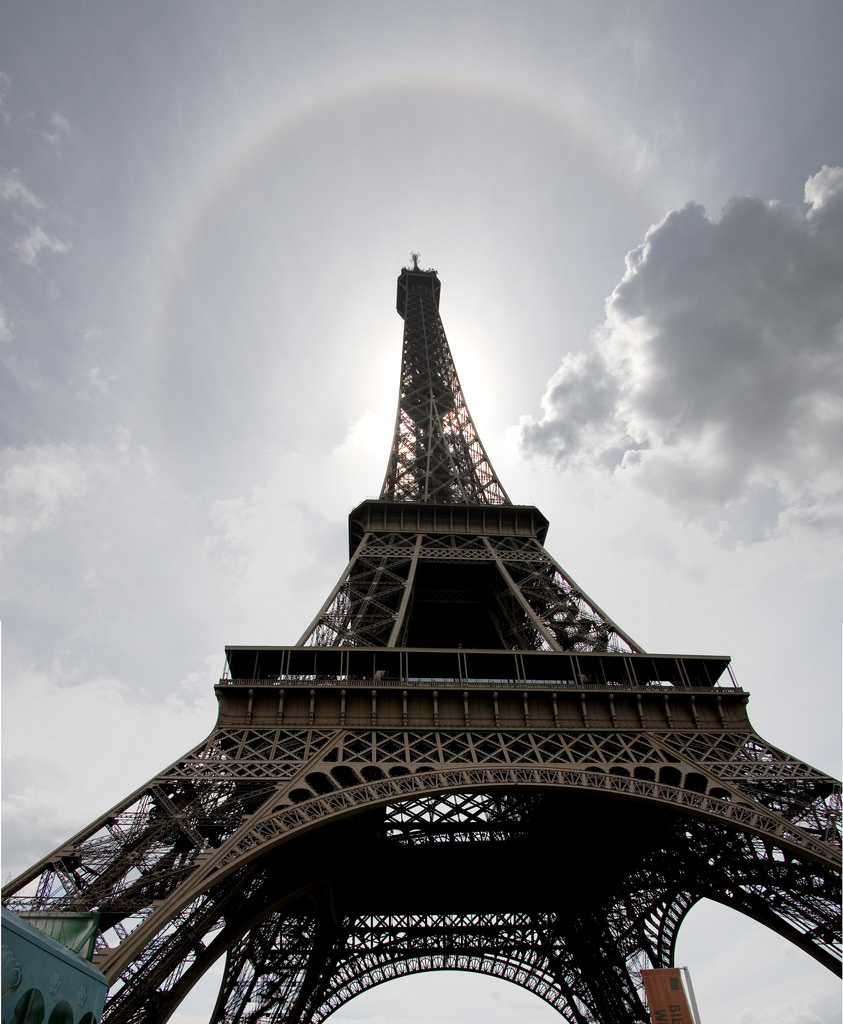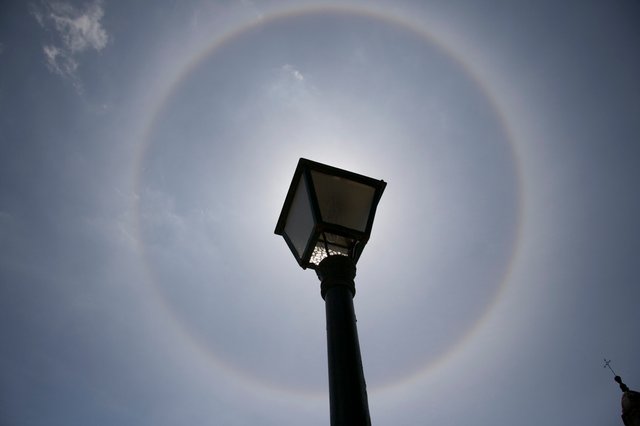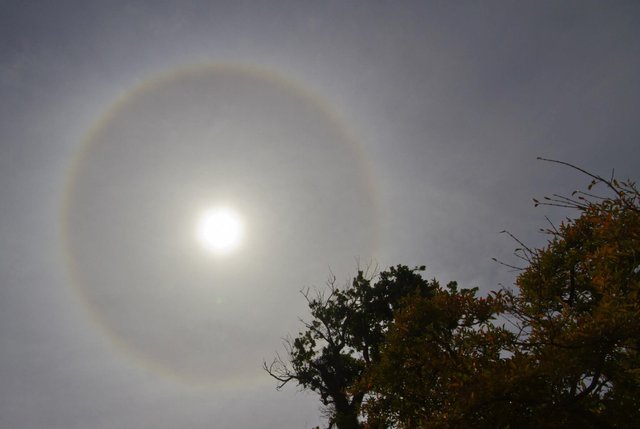The beauty of the 22 degree solar halo

(taken by me back in 2008)
A photon is produced in a fusion reaction at the centre of the sun a million years ago. It whizzes out, carrying momentum, and soon after it has left the fused atoms, it collides with an electron and is absorbed. That electron, kicked with a little more energy soon spits out the photon and the photon zooms on until, in a fraction of a second, it is absorbed by another electron. This photon pin-ball game carries on...and on...and on...sometimes the photon gets further from the centre of the sun, sometimes it gets closer. On average, over time, it gets further from the centre (as the square root of the time). In fact, it's not really the same photon that is getting absorbed and emitted, but the path of energy is continuous.
It takes a long, long time for a photon, on average, to leave the sun. In fact, that photon that was produced in the centre of the sun a million years ago finally left the surface of the sun around 8 minutes ago and started hurtling towards the earth. If you look up in around 20 seconds, it might just bounce of a wall and enter your eye and interact with a retinal ganglion cell where the energy will then be converted to an electrochemical signal which will then reach the back of your brain and you will see the tiniest flash of light, which started, a million years ago with the fusion of two hydrogen atoms.
So, that's the path of a lot of photons from the sun, but I want to talk about another possibility. Not the stuff inside the sun, but the stuff in between the sun and your eye...actually, between the upper atmosphere and your eye.
As the light travels through the atmosphere, it is in constant danger of hitting an atom and being scattered. If the wavelength of the photon corresponds to blue light, then it is in great danger of being scattered, and will just become a part of the blue sky that we see everywhere but the sun itself. But we're going to look at the path of one of the photons that does not scatter of any air molecule. Instead, we're going to look at the possibility of it interacting with water.
In fact, we're going to go even more specific than that, and see what happens if it interacts with an ice crystal, floating in a cirrus cloud (http://ww2010.atmos.uiuc.edu/(Gh)/guides/mtr/cld/cldtyp/hgh/crs.rxml). These wispy clouds are relatively high up in the sky, and can be seen often throughout the year, though they often portent a change in the weather for the worse.
Ice takes on many forms, depending on the temperature and pressure that it is created in. But we are going to look purely at atmospheric pressure and perhaps 20 or 30 degrees below zero. In these conditions, ice forms a hexagonal structure, though that structure may be like a hexagonal plate, and it may be like a hexagonal tube, and it can be many things in between.
Let's say that we have those tubular, column crystals of ice. They are floating up there in the cirrus clouds in all different orientations.
Our photon, having started its journey a million years ago, whizzes through the atmosphere until it comes up a hexagonal ice crystal, and its path is deviated slightly. In fact, depending on the wavelength of the light, the angle by which it deviates will vary, and thus the ice crystal will split light into its different colours. However, most of the light will be diverted from its original path by around 22 degrees.
http://atoptics.co.uk/halo/circ1.htm
So, if the ice crystal was precisely in the line of sight between you and the sun and the photon hits the crystal, its path will be sent off by around 22 degrees, and it will no longer reach you.
However, light which was moving on a path at an angle of 22 degrees away from the line between you and the sun, on hitting an ice crystal may be perfectly deflected to now reach you. You will off course see this photon at an angle of around 22 degrees away from the sun. Better than this, all light in a ring, at 22 degrees deviation from the line between you and the sun will be the light which has hit the crystals, and this light will have been split into its constituent colours. The effect, is a beautiful, coloured ring of light around the sun...a 22 degree solar halo. http://atoptics.co.uk/halo/circular.htm
The series of events which lead up to this seem so strange and coincidental that we might expect them never to happen, but actually they happen all the time, and are there for your viewing pleasure if you only know to look. I have been photographing 22 degree solar halos for well over a decade now and love to point them out to people in the street when I see them (on average once every 2-4 weeks). It is lovely to see people suddenly discover a new earthly phenomenon that they never knew existed....and that is why I'm writing this post.
Look out for cirrus clouds, take sunglasses with you, don't look directly at the sun, and keep your eyes peeled for these beautiful effects. Here are a few of my personal photos of these.
Taken by me in Santiago de Compostela in 2008:

Taken by me in Cape Town around 2015

Taken by me in Cape Town around 2010

Wow! Very amazing pics 😊
Thank you :-)
Your welcome 😊
Looooooove this post :)